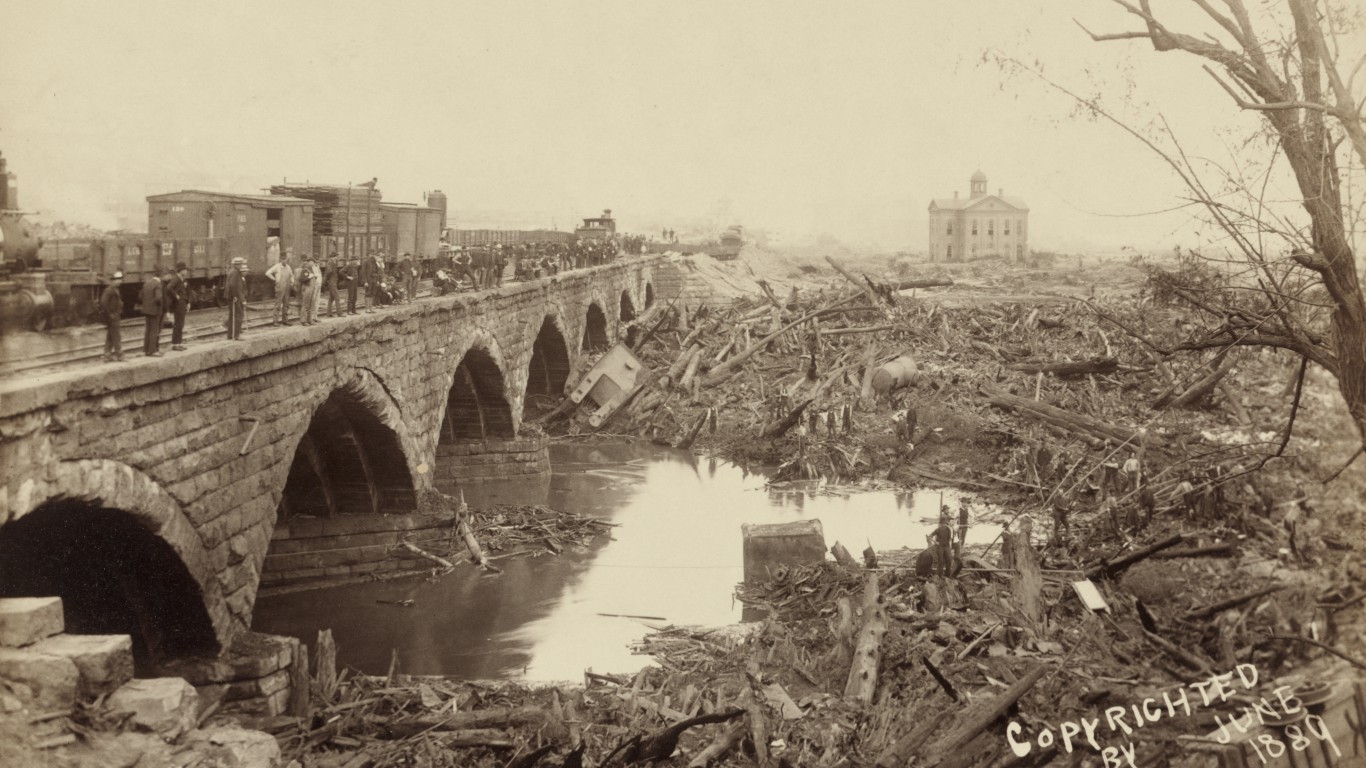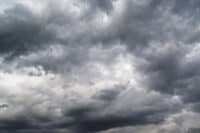
The U.S. averaged 110 flooding-related fatalities a year from 2013 to 2022, according to data from the National Weather Service. So far in 2023, 26 people have died from flooding events, which is the most lethal of all the weather events in the United States. Even as weather forecasting technology improves, nature’s powerful forces remain unpredictable and often deadly.
To find the worst floods in U.S. history by the number of fatalities, 24/7 Wall St. used government sources such as the NWS Weather Forecast Office, the National Oceanic and Atmospheric Administration, and the U.S. Geological Survey as well as media reports about flood events. In order to capture the scope of these tragic historical chapters in our nation’s history, we tried to include any and all weather-related events that could have contributed to floods.
Much of the severe flooding in America has occurred around the Mississippi River and in Texas, as well as along the Gulf Coast and Florida, because those areas are vulnerable to hurricanes. (These are 20 states with the highest risk of flooding.)
There are three categories of floods: flash flooding, river flooding, and coastal flooding.
The most dangerous are flash floods, caused by rainfall intensity and duration. Topography also plays a role – if the soil is too sodden with moisture, it may not be able to absorb rainfall.
Flash flooding can also lead to mudslides, particularly in western states. Steep ravines and canyons can funnel high volumes of water, exacerbating flood intensity. Other reasons for flash flooding are the rupture of a dam, slow-moving storms, or a surge of water released from an ice jam.
There were historic consequences from the Mississippi River flooding in 1927. Black Americans living in the flood zone were forced to evacuate their homes in the South, accelerating what would become known as the Great Migration to northern cities. (See the states where the most people were displaced by natural disasters last year.)
A more recent example of fatalities from coastal flooding and storm surge was Hurricane Ian. That tempest slammed into Florida, the Carolinas, and Virginia in September and October 2022, causing approximately 155 fatalities in the U.S., mostly in Florida, plus at least five in Cuba.
Climate change has raised concerns of increased flooding and the impact that flooding from rising sea levels will have on those living on American coasts. Scientific advances, including better observational data, improved climate models, and more sophisticated detection methods have made it possible to attribute extreme weather events to rising global temperatures.
Click here to see the worst floods in American history.
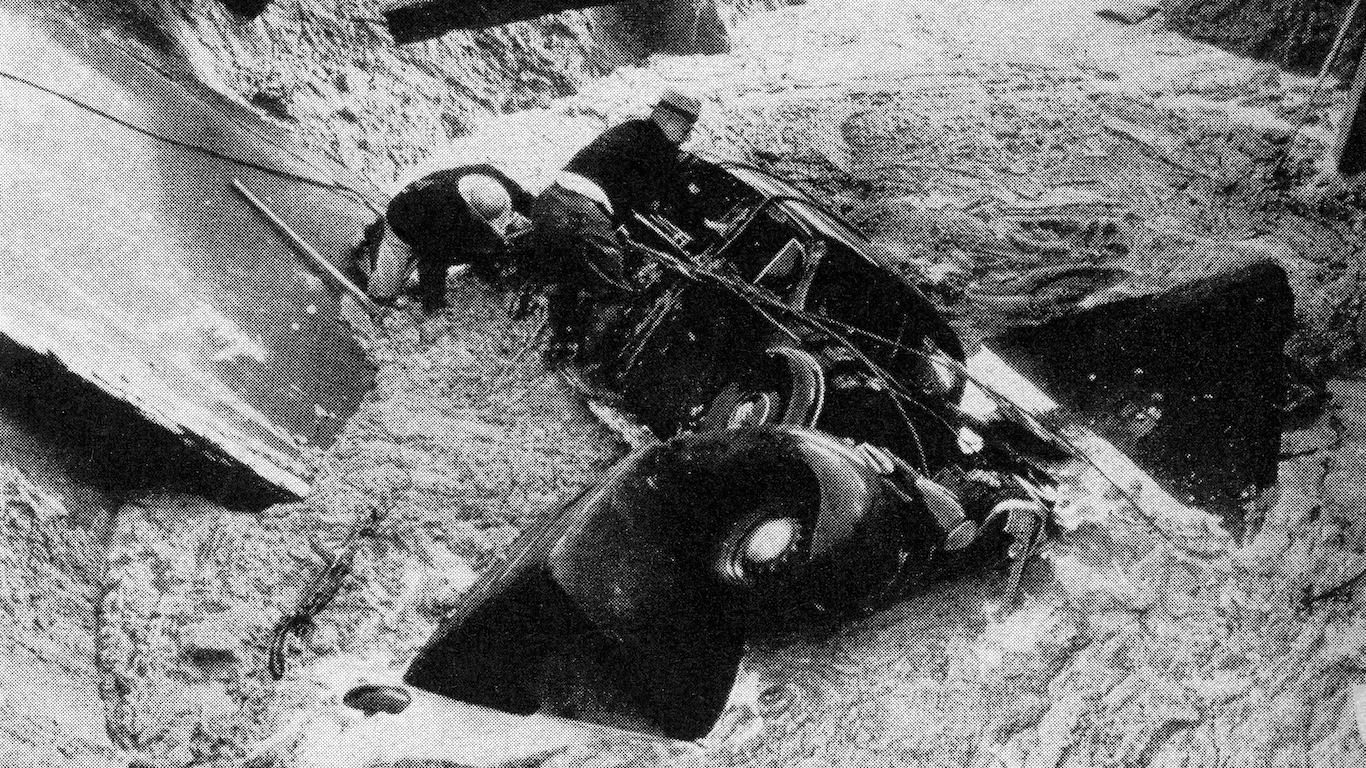
30. Los Angeles flood
> Affected area: Los Angeles, California
> Date of event: 1938
> Fatalities: 115
> Cost: $1.24 billion
After a few years of dry weather, Los Angeles received five days of rain from two storms starting on Feb. 27, 1938. Excessive rainfall caused the Los Angeles, San Gabriel, and Santa Ana rivers to overflow. Bridges, roads, and buildings were wiped out; phone lines were downed; and whole communities were cut off. The destruction from the flood prompted the city to rethink zoning and planning decisions that led to the creation of today’s Los Angeles.
[in-text-ad]
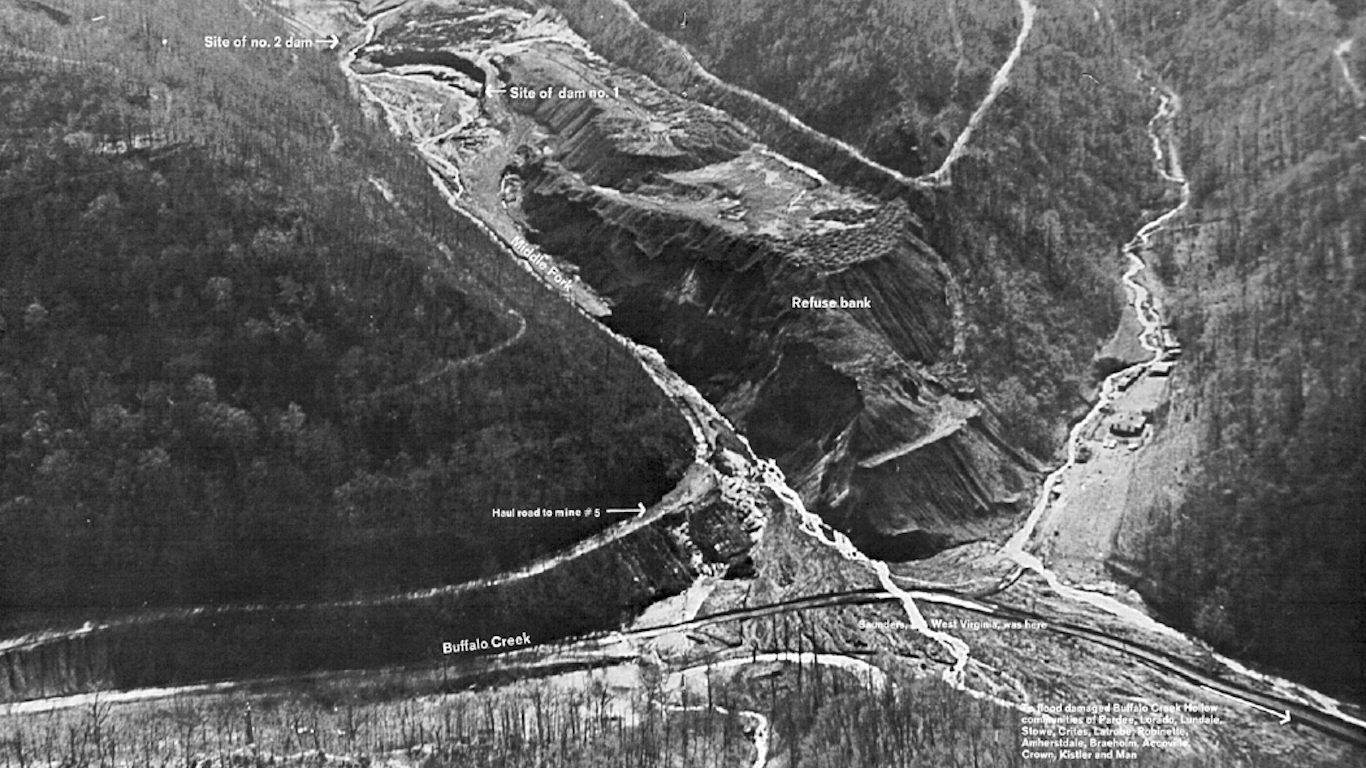
29. Buffalo Creek flood
> Affected area: West Virginia
> Date of event: 1972
> Fatalities: 125
> Cost: Unknown
West Virginia has been witness to many mining disasters, but this one occurred above ground, not below. On Feb. 26, 1972, a coal waste dam — constructed to hold water, coal waste, and silt — collapsed, releasing 132 million gallons of black ooze into a narrow valley. The wall of water was reportedly up to 20 feet high. The onslaught wiped out 17 communities downstream. Some towns were rebuilt but others vanished. State and federal investigations determined that the dam, owned and operated by the Buffalo Mining Company, was not built properly and that the mining company’s parent, The Pittston Company, had disregarded the safety of the residents. Survivors and family victims sued Pittson, and in 1974, the suit was settled for $13.5 million, or an average of $13,000 per plaintiff after legal fees.
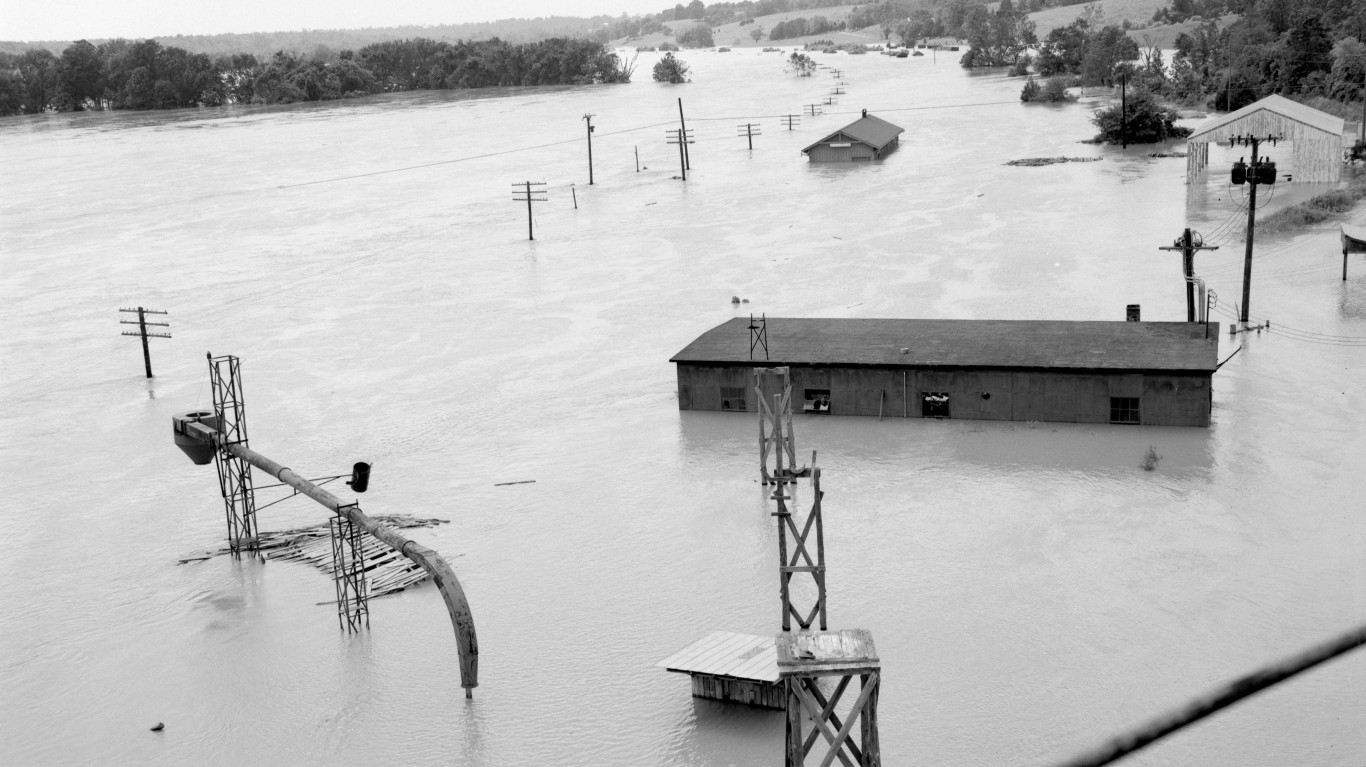
28. Hurricane Agnes flood
> Affected area: Middle Atlantic states
> Date of event: 1972
> Fatalities: 128
> Cost: $18.0 billion
1972 was a bad year for bad weather events. That year, Hurricane Agnes, one of the largest ever recorded in June, brought torrential rain to a wide swath of the eastern United States on June 19. The storm swept up 15 states in its wake. The worst impact from flooding was in Pennsylvania, where the Susquehanna and Lackawanna rivers caused significant damage to the Wilkes-Barre-Scranton metropolitan area. Even Pennsylvania’s governor had to be rescued from the governor’s mansion in Harrisburg. At the time, Agnes was the costliest hurricane in U.S. history.
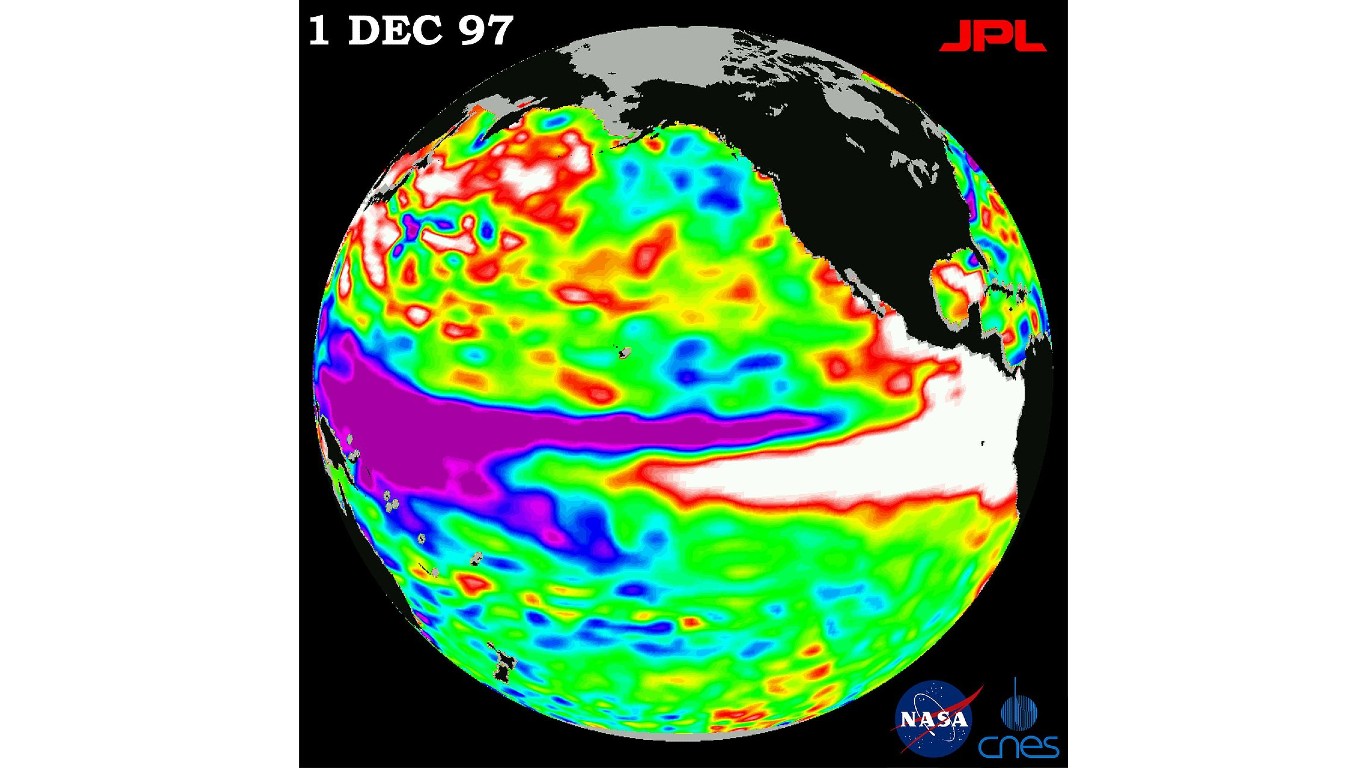
27. Southeast U.S. floods
> Affected area: Southeastern states
> Date of event: 1998
> Fatalities: 132
> Cost: $2.49 billion
The southeastern part of the United States was torn asunder by tornadoes and floods that cost the lives of 132 people. Property damage surpassed the $1 billion level. El Nino was blamed for the unstable weather, which began in the winter of 1997 and went into spring of the following year. During that winter, Florida received above-average rainfall, causing extensive flooding. In Tampa, 36 inches of rain fell that winter.
[in-text-ad-2]

26. Mill River Dam
> Affected area: Western Massachusetts
> Date of event: 1874
> Fatalities: 139
> Cost: Unknown
The failure of the Mill River Dam in Massachusetts, a major disaster in the late 19th century, is an example of an avoidable tragedy. The reservoir dam was built in the hills above Williamsburg and Northampton in western Massachusetts. It burst during the early hours of May 16, 1874, and water cascaded down a narrow valley of factories and farms. About 600 million gallons of water flooded the area, rising to 40 feet. An hour later, 139 people were dead. Investigations revealed that the dam was poorly built, but no one was held accountable. The tragedy prompted residents in western Massachusetts to adopt stricter safety measures for reservoir dams.
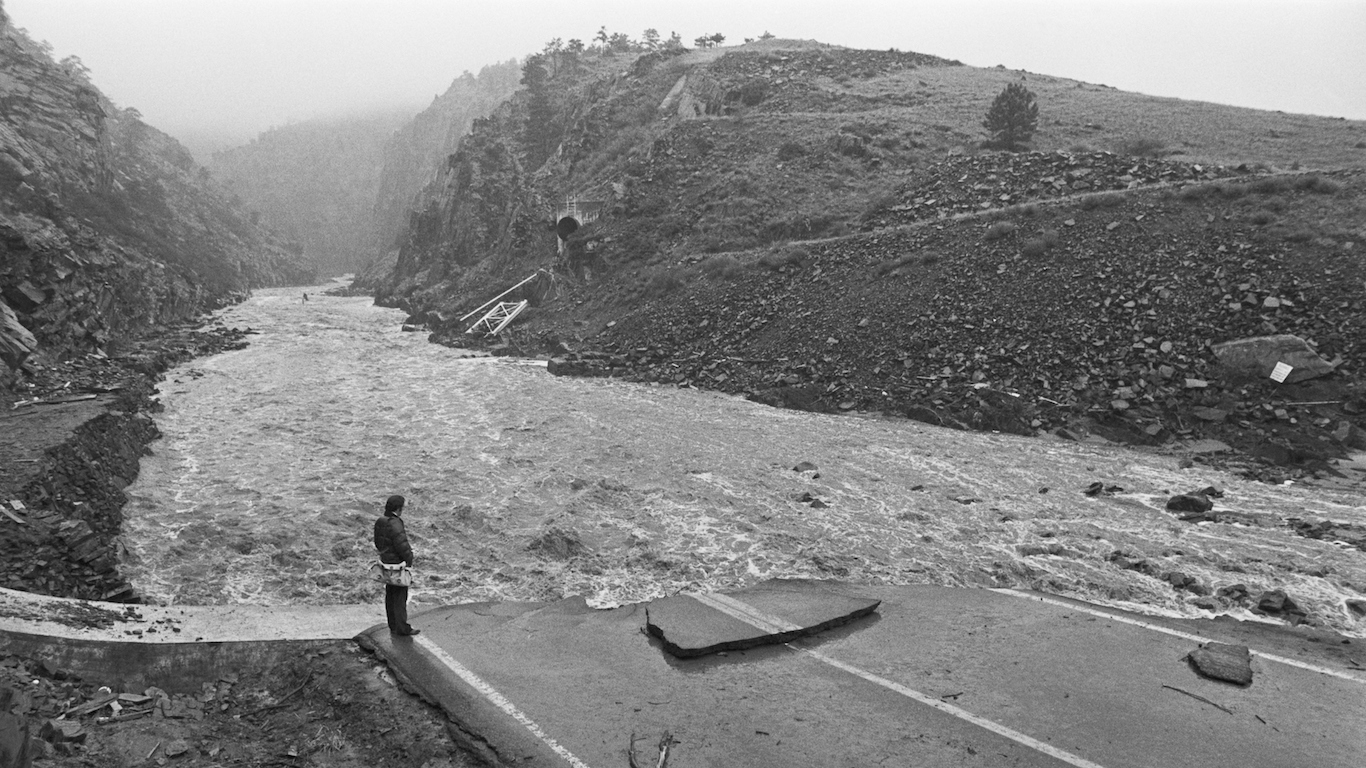
25. Big Thompson Canyon Flood
> Affected area: Big Thompson Canyon, Colorado
> Date of event: 1976
> Fatalities: 144
> Cost: $156.3 million
The Big Thompson Canyon Flood marred the centennial celebration of Colorado becoming a state. Party-goers had gathered in the canyon on July 31 to celebrate the centennial. In late afternoon, a light rain began to fall. It turned heavy in early evening. In a two-hour span that evening, a year’s worth of rain fell in the region. Water cascaded down mountainsides. At 10:30 p.m., a massive wave of water 20 feet high roared through the canyon, washing over everything ahead of it. Helicopters were deployed to find the 144 victims of the flood.
[in-text-ad]
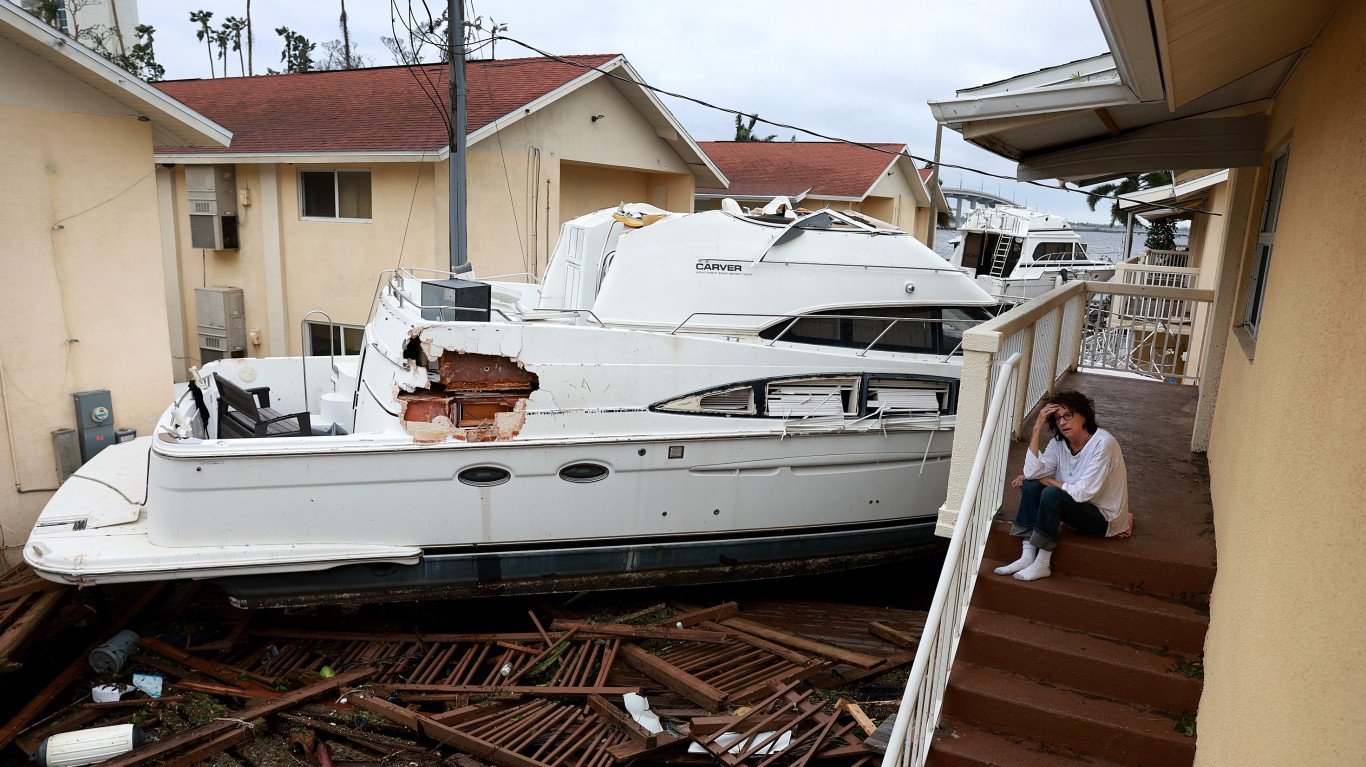
24. Hurricane Ian
> Affected area: Southeast U.S.
> Year: 2022
> Fatalities: at least 155 in US (plus 5 in Cuba)
> Cost: Up to $112.9 billion
Hurricane Ian struck the southeastern U.S. in September and October 2022 as a Category 4 storm, packing winds of 150 mph, tying it for the fifth-strongest storm ever to strike the U.S. After ravaging western Cuba, the tempest landed in southwest Florida, becoming the first Category 4 hurricane to slam that part of the state since Hurricane Charley in 2004. Ian plowed through central Florida and hit the Carolinas and Virginia, leaving at least 155 dead in its wake in the U.S. and five more in Cuba. A report in January from the NOAA put the destruction cost as high as $112.9 billion.
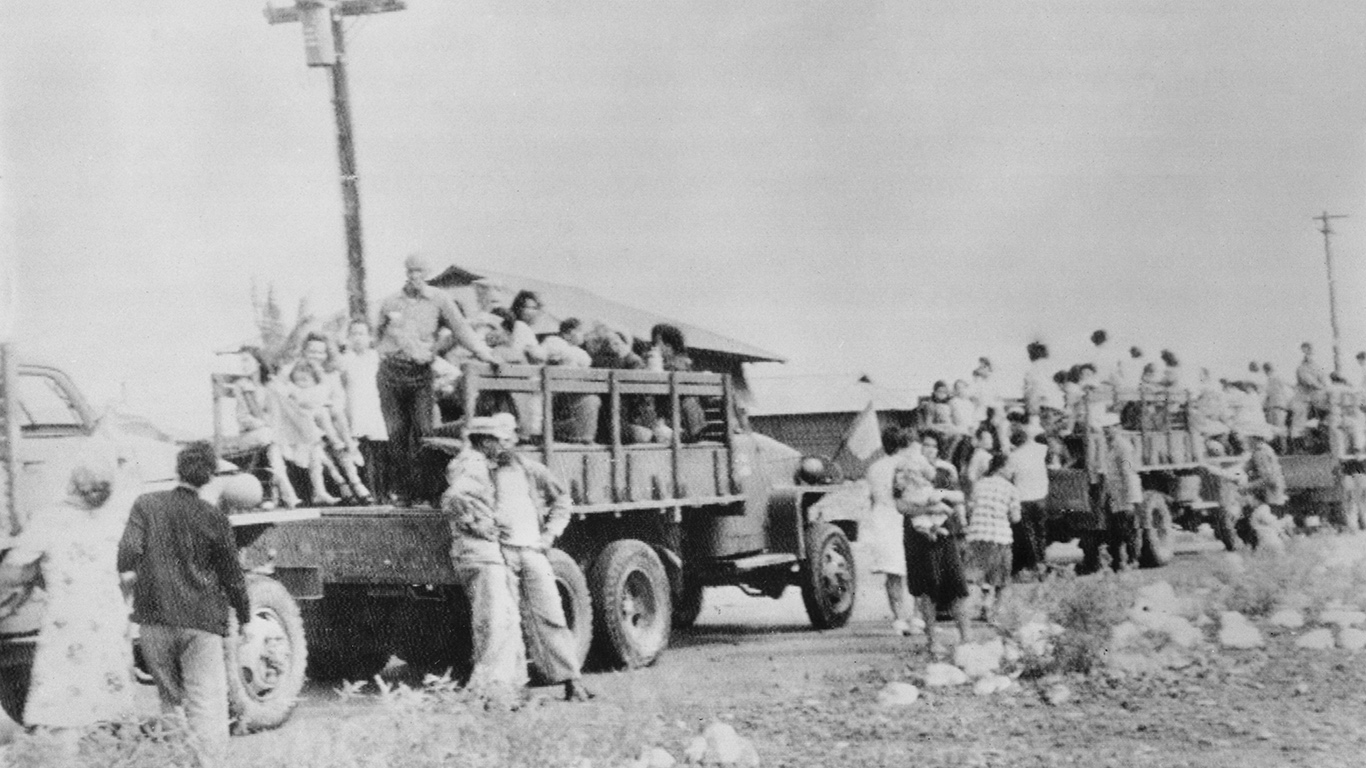
23. Pacific tsunami
> Affected area: Hawaii, Alaska
> Date of event: 1946
> Fatalities: 165
> Cost: $334.1 million
The Aleutian Islands earthquake launched a tsunami on April 1, 1946, that overwhelmed parts of Alaska and Hawaii. Unimak Island in the Aleutian island chain was first hit by a 100-foot wave that wiped out a lighthouse 30 feet above sea level, killing five people. The wave headed south to Hawaii where it slammed into Hilo, erasing a third of the city. A schoolhouse in another part of the island state was destroyed, killing a teacher and 25 students.
22. Brazos River Flood
> Affected area: Freeport, Texas
> Date of event: 1913
> Fatalities: 177
> Cost: $88.7 million
The Brazos River Basin was familiar with periodic flooding, which helped cotton farmers grow their crop. Still, area residents were not prepared for what happened on Dec. 5, 1913. Heavy rain began falling on already elevated river water levels, and water overflowed the riverbank and washed into East Waco. Two people were killed by the surging river, and businesses were damaged. Farther south, the Brazos River and Colorado River overflowed their banks and combined, the deluge eventually killed 177 people. The flood prompted action to protect the city of Waco from further flooding.
[in-text-ad-2]
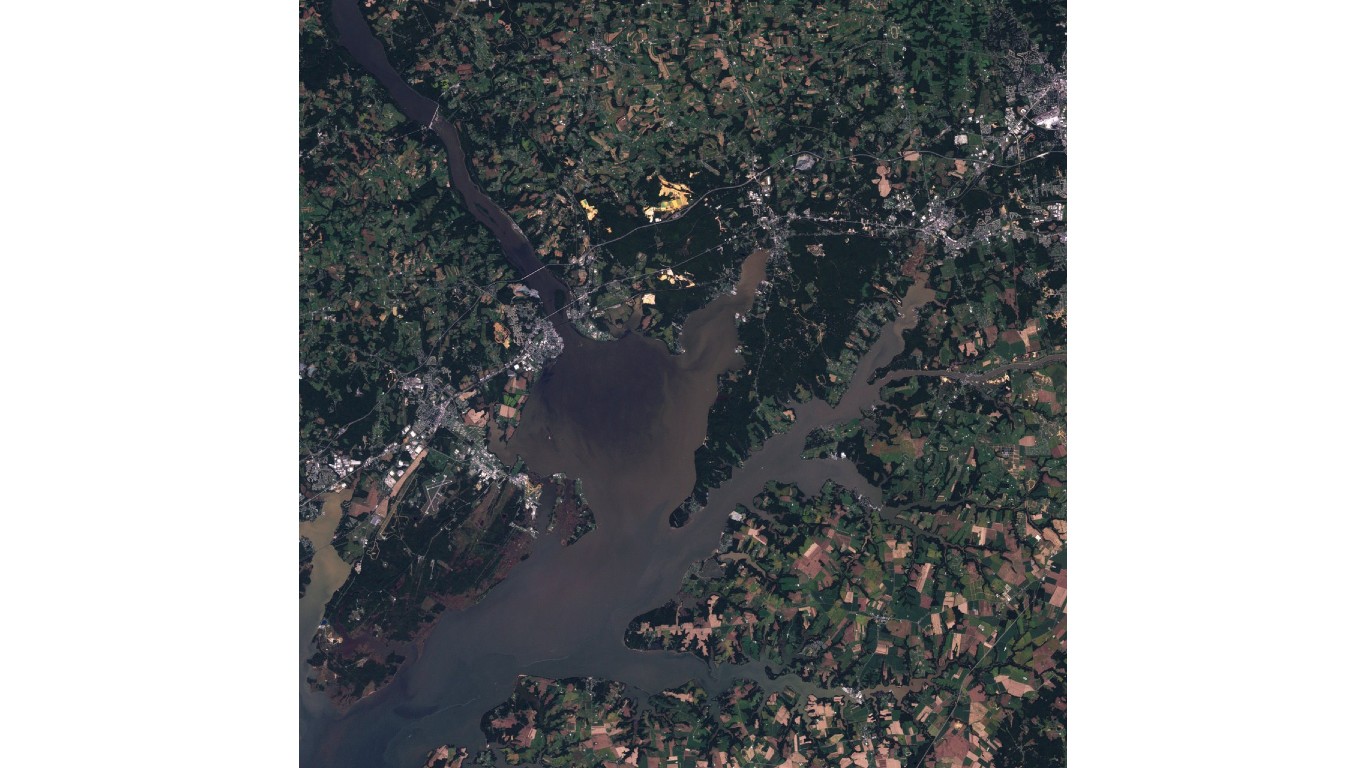
21. Floods in eastern U.S.
> Affected area: Appalachians, Mid-Atlantic, Northeast
> Date of event: 1996
> Fatalities: 187
> Cost: $4.79 billion
Blizzards are bad enough, but when a heavy volume of snow melts causing flooding, that is a deadly one-two punch. Such was the case in early 1996, when that combination overwhelmed many states in the eastern United States. The Susquehanna River overflowed its banks and flooded low-lying areas. More than 3 inches of rain fell in 24 hours at Williamsport, Pennsylvania. That rainfall led to some of the worst flooding in the Keystone State since Hurricane Agnes 24 years earlier.
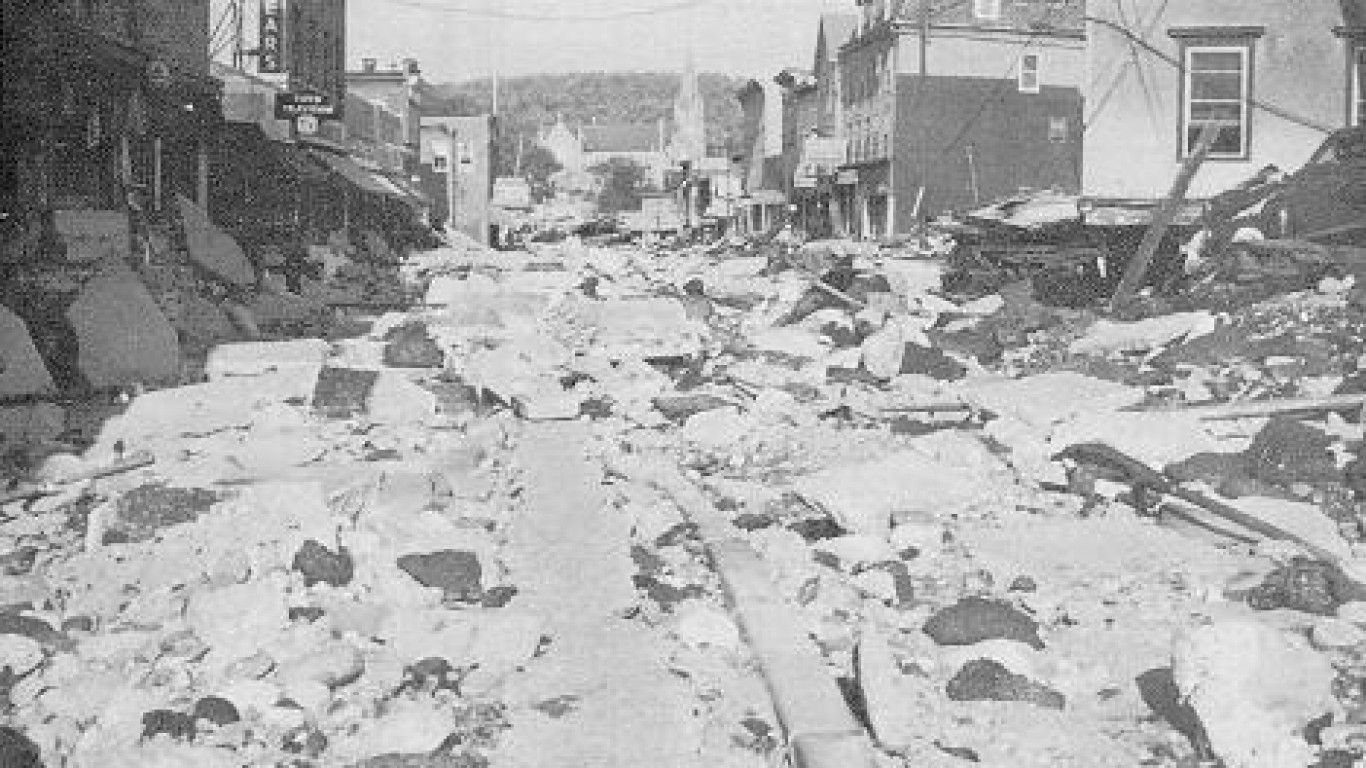
20. East Coast floods
> Affected area: East Coast states
> Date of event: 1955
> Fatalities: 200
> Cost: $7.78 billion
Back-to-back hurricanes led to extensive floods on the East Coast in August 1955. At the time, Hurricane Diane, the second of the two storms to strike the region, was the costliest storm on record. The heaviest rain fell in northern Virginia, with more than 5 inches inundating the region in 24 hours. More than 200 dams In New England either partially or completely failed.
[in-text-ad]

19. Great Northeast Flood
> Affected area: Maryland to Maine
> Date of event: 1936
> Fatalities: 200
> Cost: $85.2 billion
The massive flood that engulfed half of the eastern United States, almost biblical in scope, started with snowmelt, then a downpour, on March 11 that did not relent for 14 days. The tiny town of Pinkham Notch recorded rainfall of more than 22 inches over the period. Rivers throughout New England states overflowed. At the Vernon Dam in Vermont, flood waters from the Connecticut River rose 19 feet above the dam. About 200 people lost their lives, and 14,000 were made homeless. Because of the disaster, Congress passed the Flood Control Act of 1936, which President Franklin Roosevelt then signed. The act empowered the Army Corps of Engineers to build levees, flood walls, and reservoirs.
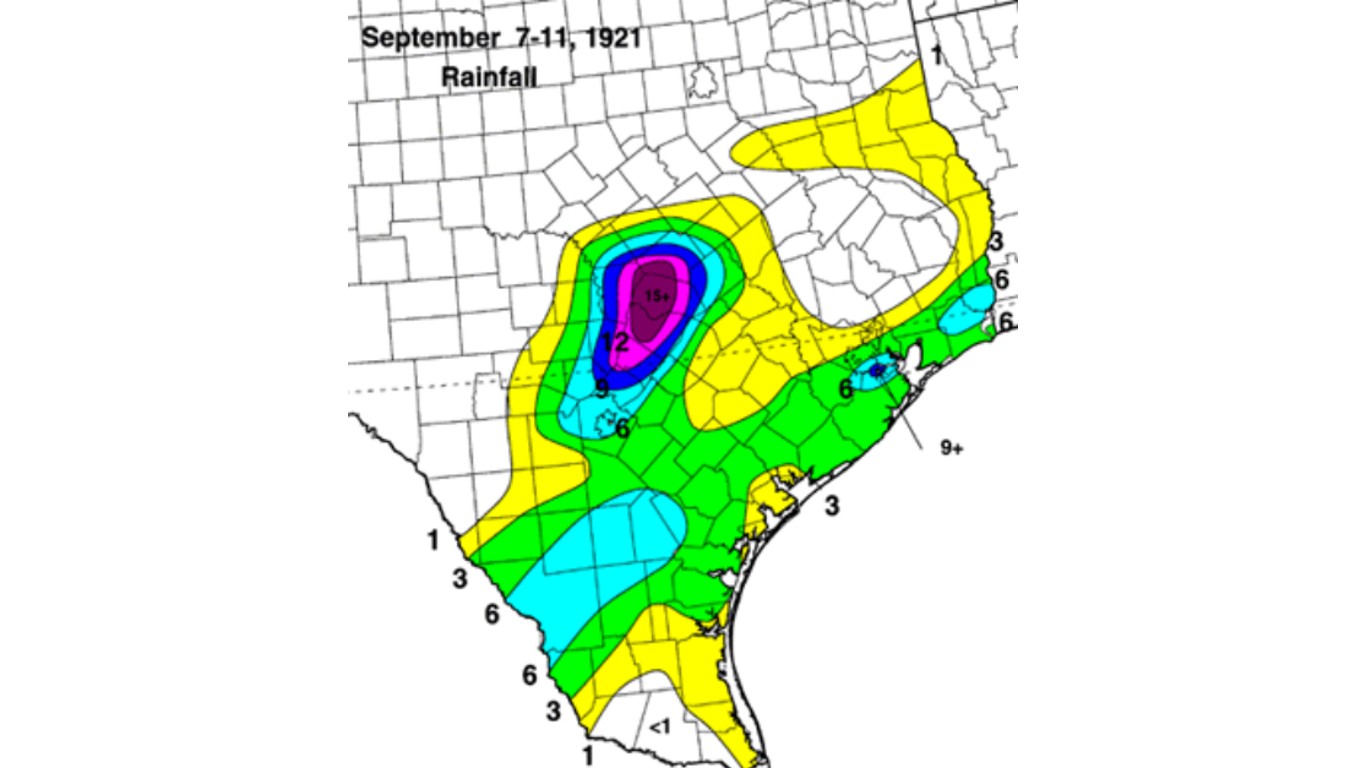
18. Texas flood
> Affected area: Parts of Texas
> Date of event: 1921
> Fatalities: 215
> Cost: $70.2 million
The rainstorm in Texas in 1921 is considered the greatest such event in the history of the Lone Star State. The storm entered the region as a hurricane in Mexico and brought torrential rain in Texas as it moved in a northeasterly direction. In its path, 215 people were killed. The rainfall left up to 9 feet of water in downtown San Antonio. In the town of Taylor, almost 24 inches of rain fell in 35 hours as measured at the U.S. Weather Bureau station on Sept. 9-10.

17. Superstorm Sandy
> Affected area: New Jersey, New York
> Date of event: 2012
> Fatalities: 233
> Cost: $88.4 billion
By the time Sandy reached the New York metropolitan area on Oct. 29, 2012, it had been downgraded to a superstorm from a hurricane. Yet it would turn out to be one of the costliest weather events in U.S. history. Subway service in New York City was knocked out, and multi-million-dollar homes at the Jersey Shore were destroyed. The destructive force of the storm and loss of life ratched up the urgency level for preparing shoreline defenses along the New Jersey coast as well as New York City to address the reality that stronger storms are in the region’s future because of climate change.
[in-text-ad-2]

16. Black Hills Flood
> Affected area: Rapid City, South Dakota
> Date of event: 1972
> Fatalities: 238
> Cost: $988.3 million
Heavy thunderstorms struck the Rapid City region of South Dakota on June 9, 1972, and because of strong easterly winds, the storm system stayed over the area. Flood water from various creeks emptied into Rapid Creek, swelling that body of water to more than 300 times its regular volume. According to the NWS, data from the stream meter on Rapid Creek above Canyon Lake showed that in a two-hour span the water level climbed 12 feet. The dam at Canyon Lake failed, and water rushed through Rapid City and the eastern foothills of the Black Hills.

15. Mississippi flood
> Affected area: Mississippi River region
> Date of event: 1927
> Fatalities: 246
> Cost: $41.7 billion
People living along the Mississippi River know it floods often — and they have learned to live with it. But no one was ready for what historians called one of the greatest peacetime disasters in U.S. history in April 1927. The Great Mississippi River Flood engulfed 16 million acres and displaced about 640,000 people from Illinois to Louisiana. In Vicksburg, Mississippi, the river swelled to 80 miles wide.
There were other consequences from the deluge. African Americans living in the flood zone were forced to leave their homes in the South, and the flood hastened what would become known as the Great Migration to northern cities as African Americans sought a better life.
[in-text-ad]
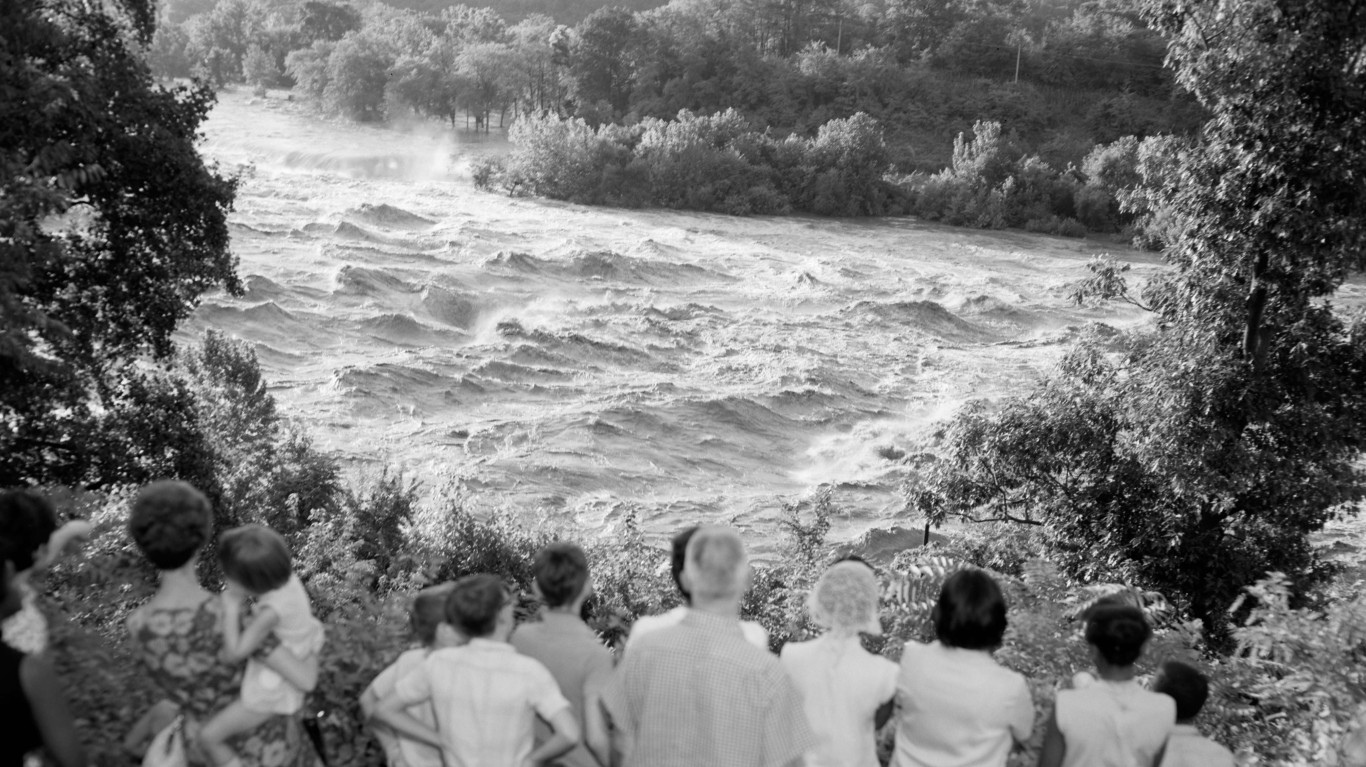
14. Hurricane Camille and flooding
> Affected area: East Coast
> Date of event: 1969
> Fatalities: 256
> Cost: $9.70 billion
Hurricane Camille was a category 5 hurricane that slammed into the Gulf Coast of Mississippi on Aug. 17, 1969 and brought a tremendous storm surge to the region. A storm tide of greater than 24 feet overflowed the town of Pass Christian, Mississippi. At the time, storm surges along that area of the Gulf Coast were the highest ever recorded in the United States. In addition to the 256 people who were killed, 20,000 were left homeless, and thousands of farm and domestic animals were drowned.
13. Brazos River flood
> Affected area: Freeport, Texas
> Date of event: 1899
> Fatalities: 284
> Cost: $271.0 million
Rain fell on the Brazos River region for 11 straight days beginning June 17, 1899. Rainfall totals reached almost 9 inches that week across 66,000 square miles of Texas. The Brazos River overflowed its banks and flooded the surrounding area for 12,000 square miles. In July, flood waters would rise over 58 feet in the town of Richmond. It wouldn’t be the last flood-related tragedy to befall the region.
12. Oregon Heppner flash flood
> Affected area: Heppner, Oregon
> Date of event: 1903
> Fatalities: 324
> Cost: Unknown
A brief, hard rain and hail in the Blue Mountains triggered a sudden and deadly flash flood through Heppner, Oregon, on June 14, 1903, drowning 324 people. Waters rose up to 40 feet high and saturated the town. The death toll would have been much higher, but towns in the path of those waters were warned ahead of time and residents were able to evacuate. It’s unclear exactly how much rain fell during the disaster because the local weather station was destroyed in the flood.
[in-text-ad-2]
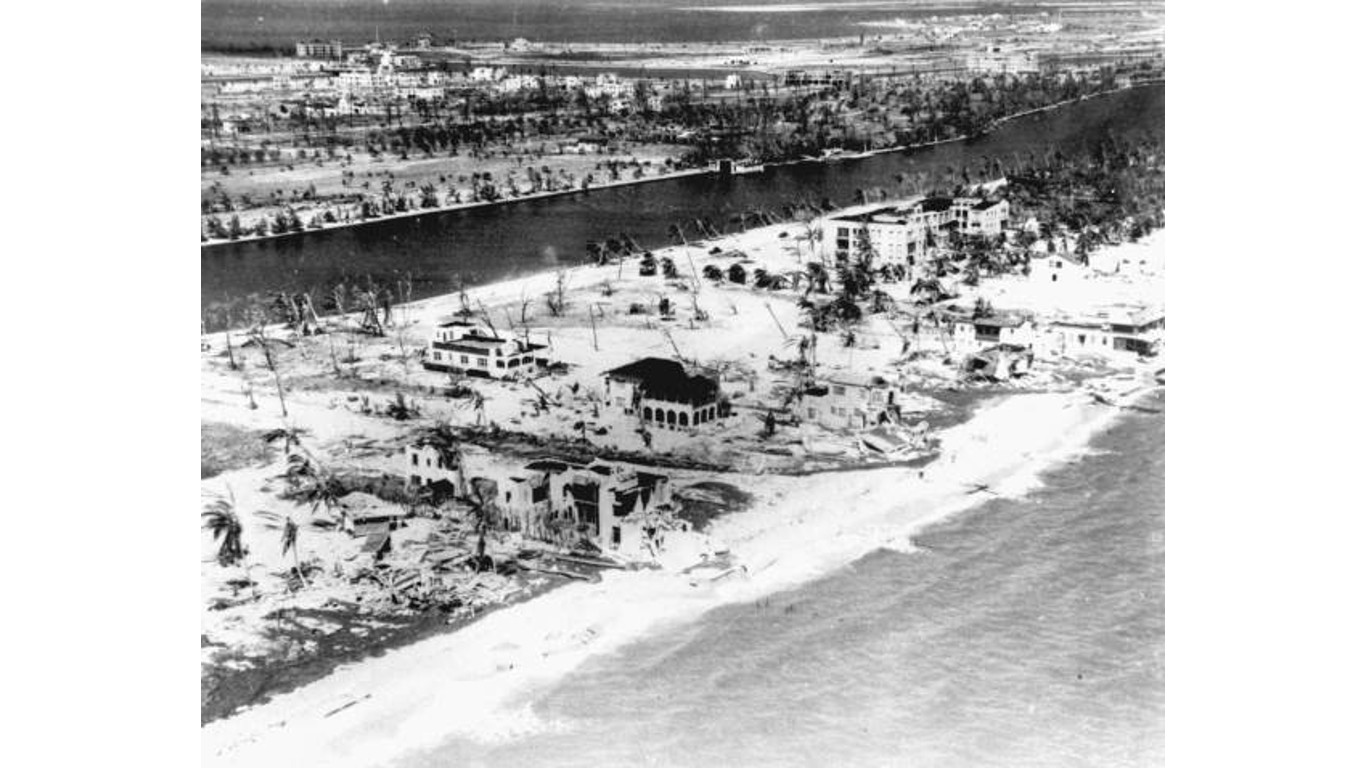
11. Miami hurricane and flooding
> Affected area: Florida Atlantic Coast
> Date of event: 1926
> Fatalities: 372
> Cost: $1.49 billion
It was bad enough that the Florida real estate market had collapsed in the mid-1920s, but then one of the worst storms ever blasted Florida and the Atlantic Coast on Sept. 18, 1926. The tempest brought deadly storm surge and flooding to the hurricane-prone area. A tidal wave swept over Miami Beach and Biscayne Bay, and boats were scattered all over the city. The storm left 372 people dead and up to 6,000 injured. There had been some advance warning of the approaching hurricane from reports from ships in the area, but in 1926, few people had radios and there were few methods to pass along the warning to the population. Property damage was the highest in U.S. history to that point.

10. The Ohio River Flood
> Affected area: Pennsylvania, Ohio, West Virginia, Kentucky, Indiana, Illinois
> Date of event: 1937
> Fatalities: 385
> Cost: $151.6 billion
How bad was the Ohio River Flood in 1937? The NWS said the deluge “surpassed all previous floods during the 175 years of civilized occupancy of the lower Ohio Valley.” The flood started in late January 1937 and was bolstered by record rainfall in river cities such as Louisville, Kentucky (20 inches); Evansville, Indiana (15 inches); and Cincinnati, Ohio (14 inches). The NWS said 70% of Louisville was under water. The Cincinnati Enquirer reported that one-fifth of Cincinnati was under water. The nightmare got worse — as the water rose, gas tanks exploded and oil fires ignited along the river.
[in-text-ad]
9. Labor Day Hurricane
> Affected area: Florida Keys, Florida
> Date of event: 1935
> Fatalities: 500
> Cost: Unknown
The 1920s were a difficult time to live in Florida because of the real estate collapse and severe weather events, and the Labor Day Hurricane of 1935 brought even more misery to the Sunshine State. The category 5 tempest devastated the Florida Keys, producing a storm surge of up to 20 feet above sea level. The railroad connecting the Keys to the mainland was destroyed. Among the scores who died were World War I veterans who were building a highway and living in federal rehabilitation camps. After the storm, Ernest Hemingway traveled to the Keys to help with the recovery. What he saw prompted him to write a scathing magazine article titled “Who Killed the Vets?”
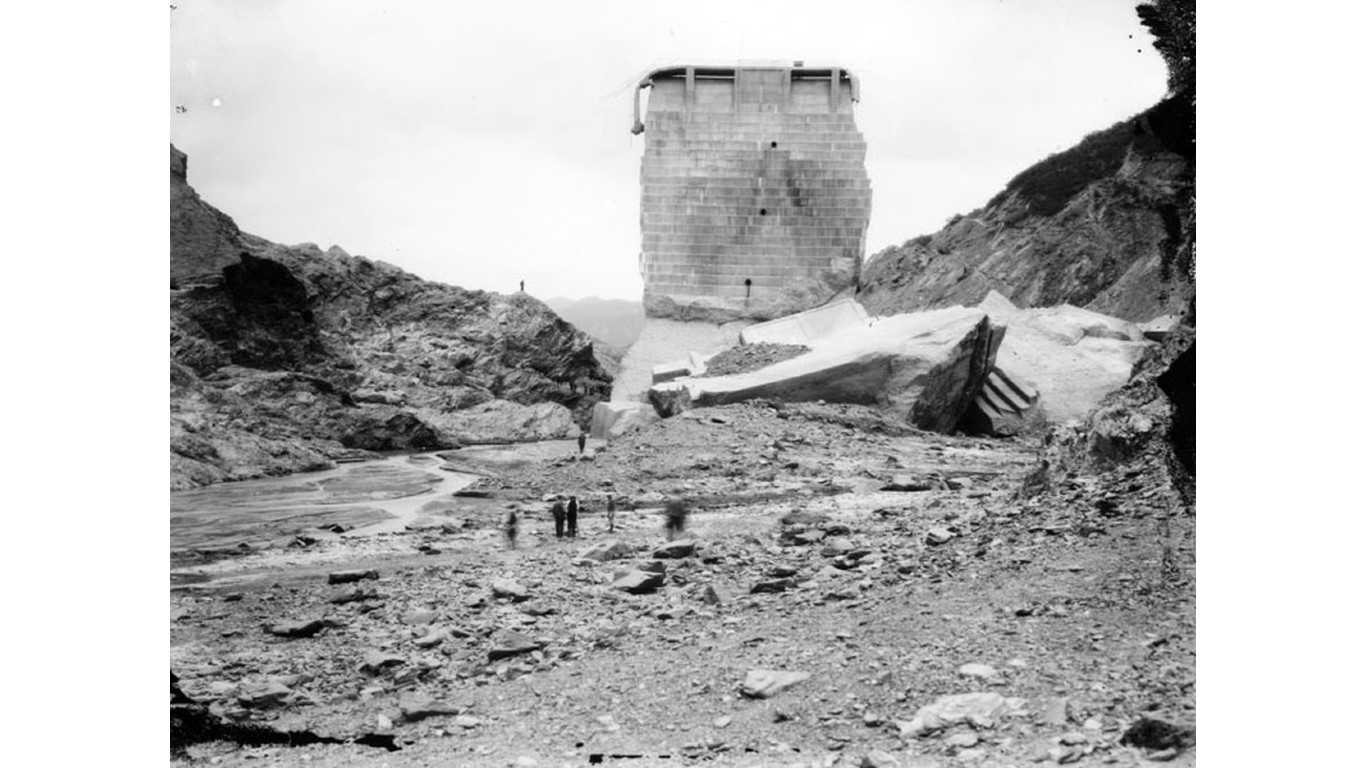
8. St. Francis Dam failure
> Affected area: Los Angeles, California
> Date of event: 1928
> Fatalities: 400-600
> Cost: $291.8 million
The St. Francis Dam failure was the second-worst disaster in California’s history after the San Francisco Earthquake and among the greatest dam catastrophes in U.S. history. Built in 1926, the dam was the creation of self-taught civil engineer William Mulholland. The 1,300-foot dam held more than 12 billion gallons of water, enough to supply Los Angeles for a year. But there were integrity issues with the dam from the beginning. On the morning of March 12, 1928, the dam keeper noticed muddy leaks emerging from the dam. He summoned Mulholland and his chief assistant, who inspected the dam and said it was safe. Twelve hours later, the dam keeper and his 6-year-old son would be the first drowning victims after the dam gave way. The wall of water would surge 54 miles until it reached the Pacific Ocean.
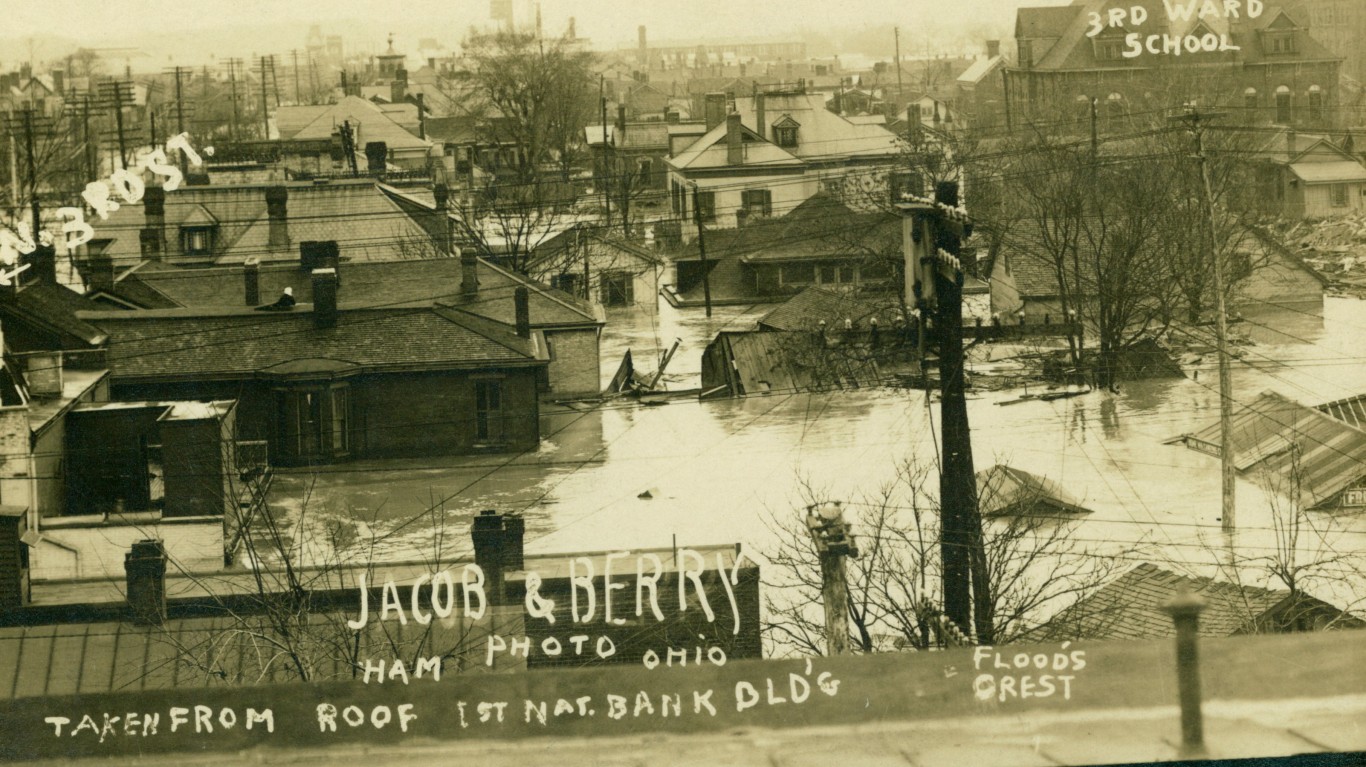
7. Statewide Ohio flood
> Affected area: Ohio
> Date of event: 1913
> Fatalities: 467
> Cost: $82.4 billion
The worst weather event in Ohio history occurred in late March 1913, killing 467 people and flooding 40,000 homes. Excessive rainfall all over the state caused the flood. In Dayton, swiftly flowing water as deep as 10 feet deep swept through downtown streets, killing 123 people. Downstream on the Miami River, 100 more people died in Hamilton, where water rose to as much as 18 feet deep. Another 100 people died in Columbus, where survivors were plucked from trees and rooftops. At Cincinnati, the Ohio River rose 21 feet in 24 hours. Hoping to avoid a repeat of the calamity, flood control reservoirs were established by the Miami Conservancy District after the flood of 1913.
[in-text-ad-2]
6. New England hurricane and flooding
> Affected area: New England, Long Island
> Date of event: 1938
> Fatalities: 700
> Cost: $5.44 billion
On Sept. 21, 1938, one of the most famous nor’easters of all time destroyed much of eastern Long Island before it unleashed its wrath on New England. It was a fast-moving storm that the NWS said was moving at 47 mph, and it produced up to 7 inches of rainfall. Tidal waves at least 50 feet high, as recorded in Gloucester, Massachusetts, overwhelmed unprotected beaches, and the deluge turned cottages into matchsticks. The region’s deadliest disaster claimed at least 700 lives, and 2,000 others were injured. More than 63,000 people were made homeless. Almost 20,000 buildings were destroyed, and 100 bridges had to be reconstructed.

5. Hurricane Katrina flooding
> Affected area: Southern Louisiana
> Date of event: 2005
> Fatalities: 1,833
> Cost: $103.9 billion
Part of the tragedy of Katrina is tied to how humans have altered the landscape around New Orleans. New Orleans was once above sea level when French settlers first arrived there 300 years ago, but swamp drainage has caused the city to sink. The areas below sea level, those most at risk to flooding, have generally been home to the city’s poorest residents. What’s more, New Orleans relied on a system of levees and seawalls built by the Army Corps of Engineers to keep the city from flooding. But when Katrina hit on Aug. 29, 2005, the levees failed. As a result, 80% of the city flooded. It was the costliest hurricane in U.S. history.
[in-text-ad]

4. South Carolina Sea Islands hurricane
> Affected area: Sea Islands
> Date of event: 1893
> Fatalities: 2,000+
> Cost: $27.9 million
In the late 19th century, people lacked the kind of weather prediction and warning system we have today. It was for this reason that South Carolina, and in particular the Sea Islands that form a barrier along the state coastline, were caught unawares by a hurricane on Aug. 27, 1893. The hurricane swept through the sea islands near Savannah, leaving more than 2,000 dead. Most died by drowning. Nearly every building on the Sea Islands was destroyed, and 30,000 people became homeless.
3. Johnstown flood
> Affected area: Johnstown, Pennsylvania
> Date of event: 1889
> Fatalities: 2,209
> Cost: $12.6 billion
On May 31, 1889, following several days of heavy rain, a dam near Johnstown burst. The size and scope of the flood that ensued is difficult to comprehend even today. Up to 2,209 people died, including 99 entire families. Bodies were found as far away as Cincinnati. Flood lines were marked as high as 89 feet above river level, and the wave that struck Johnstown was said to be 40 feet high. The South Fork Fishing and Hunting Club, whose members included industrialists Andrew Carnegie and Henry Clay Frick, owned the dam but managed to avoid liability. Historians and legal experts believe the anger over the failure to find fault in the tragedy led to stricter liability laws in the United States. It was the first major disaster in which the American Red Cross was involved.
2. South Florida hurricane and flood
> Affected area: Lake Okeechobee, Florida
> Date of event: 1928
> Fatalities: 2,500-3,000
> Cost: $1.5 billion
Barely two years after absorbing the impact of a hurricane that ravaged Miami, Florida was whipsawed by another tempest in late September 1928 — a storm that cost the lives of more people in that state than any other natural weather event. On the southern shore of Lake Okeechobee, about 6,000 people lived in a farming community, and nearly half would perish from the storm. A 5-foot mud dike constructed to hold back Lake Okeechobee gave way, letting loose a tidal wave. There were so many people killed so quickly, and the bodies decomposed so rapidly because of the heat, that the survivors had to burn the corpses. More than 600 of the dead were African Americans who were buried in unmarked graves in a West Palm Beach pauper cemetery.
[in-text-ad-2]
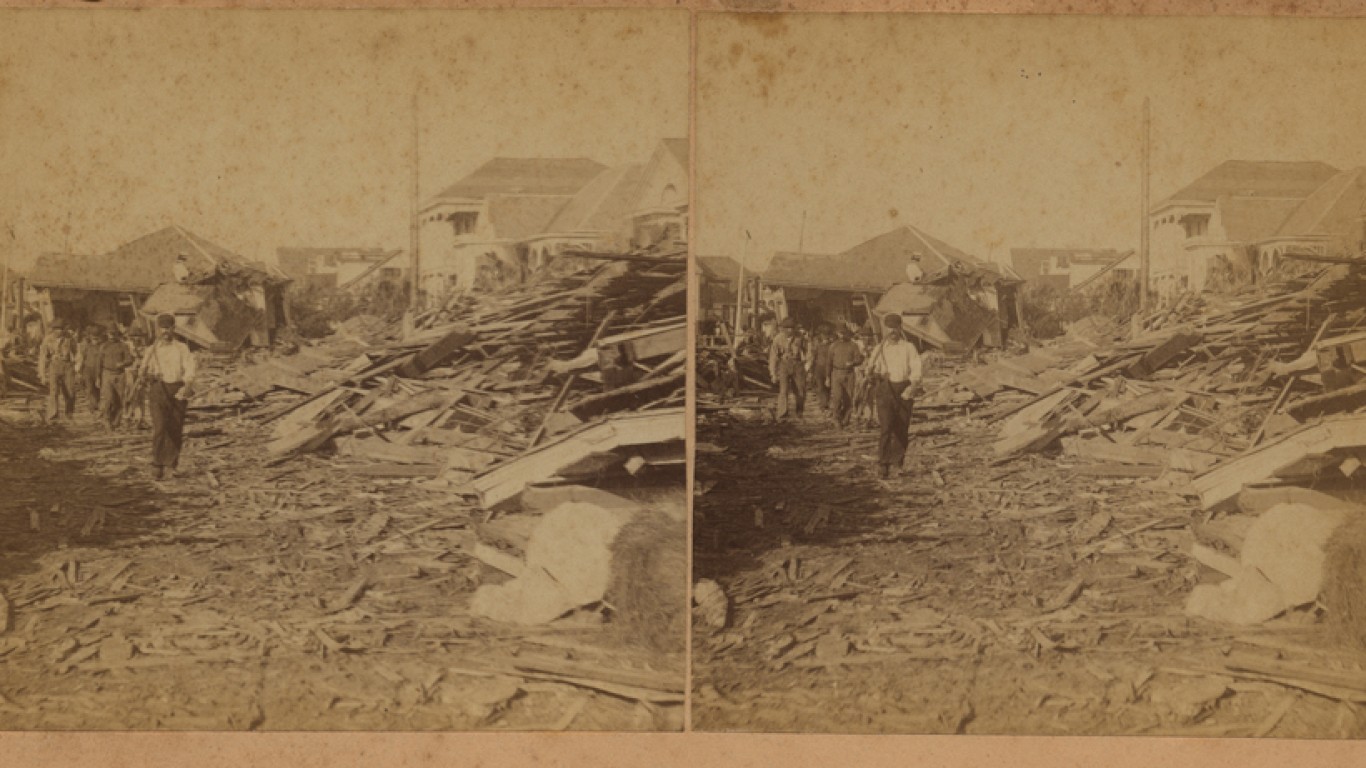
1. Galveston hurricane and storm surge
> Affected area: Galveston, Texas
> Date of event: 1900
> Fatalities: 8,000
> Cost: $602.3 million
The Galveston Hurricane of 1900 is the deadliest natural disaster in U.S. history. It’s believed that 8,000 people were killed in the high winds, 15-foot storm surge, and flooding brought on by the category 4 hurricane. But the actual number could be as many as 12,000 people.
Though the storm was powerful, many of the casualties could have been avoided. The Weather Bureau, which became the National Weather Service, predicted the storm would land much further east. Warnings from Cuba about the storm were ignored by residents and many vacationers, and the city was largely unprepared for the hurricane that slammed into it on Sept. 8, 1900. Galveston was once a booming port city, but the destruction of the hurricane was too much for the city to fully recover from as investors began to favor Houston instead.
Are You Still Paying With a Debit Card?
The average American spends $17,274 on debit cards a year, and it’s a HUGE mistake. First, debit cards don’t have the same fraud protections as credit cards. Once your money is gone, it’s gone. But more importantly you can actually get something back from this spending every time you swipe.
Issuers are handing out wild bonuses right now. With some you can earn up to 5% back on every purchase. That’s like getting a 5% discount on everything you buy!
Our top pick is kind of hard to imagine. Not only does it pay up to 5% back, it also includes a $200 cash back reward in the first six months, a 0% intro APR, and…. $0 annual fee. It’s quite literally free money for any one that uses a card regularly. Click here to learn more!
Flywheel Publishing has partnered with CardRatings to provide coverage of credit card products. Flywheel Publishing and CardRatings may receive a commission from card issuers.
Thank you for reading! Have some feedback for us?
Contact the 24/7 Wall St. editorial team.
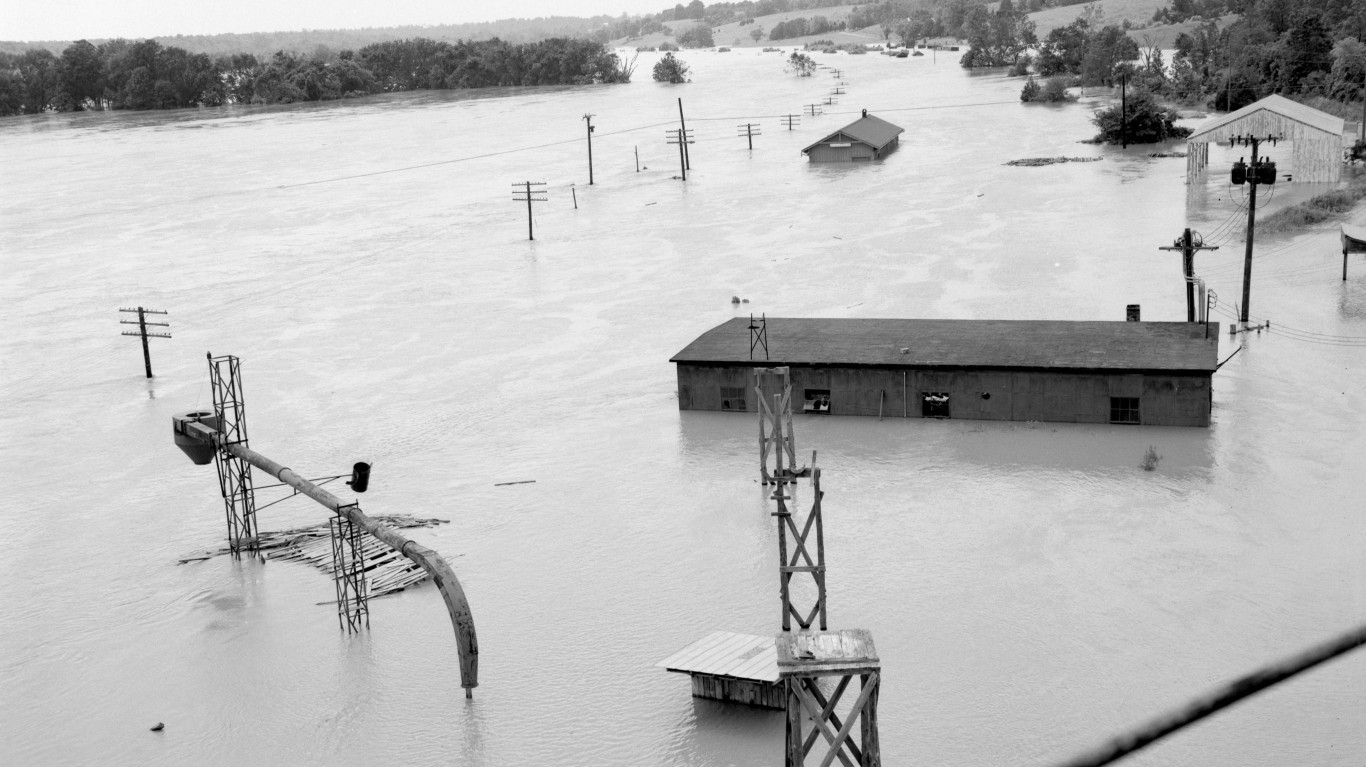 24/7 Wall St.
24/7 Wall St.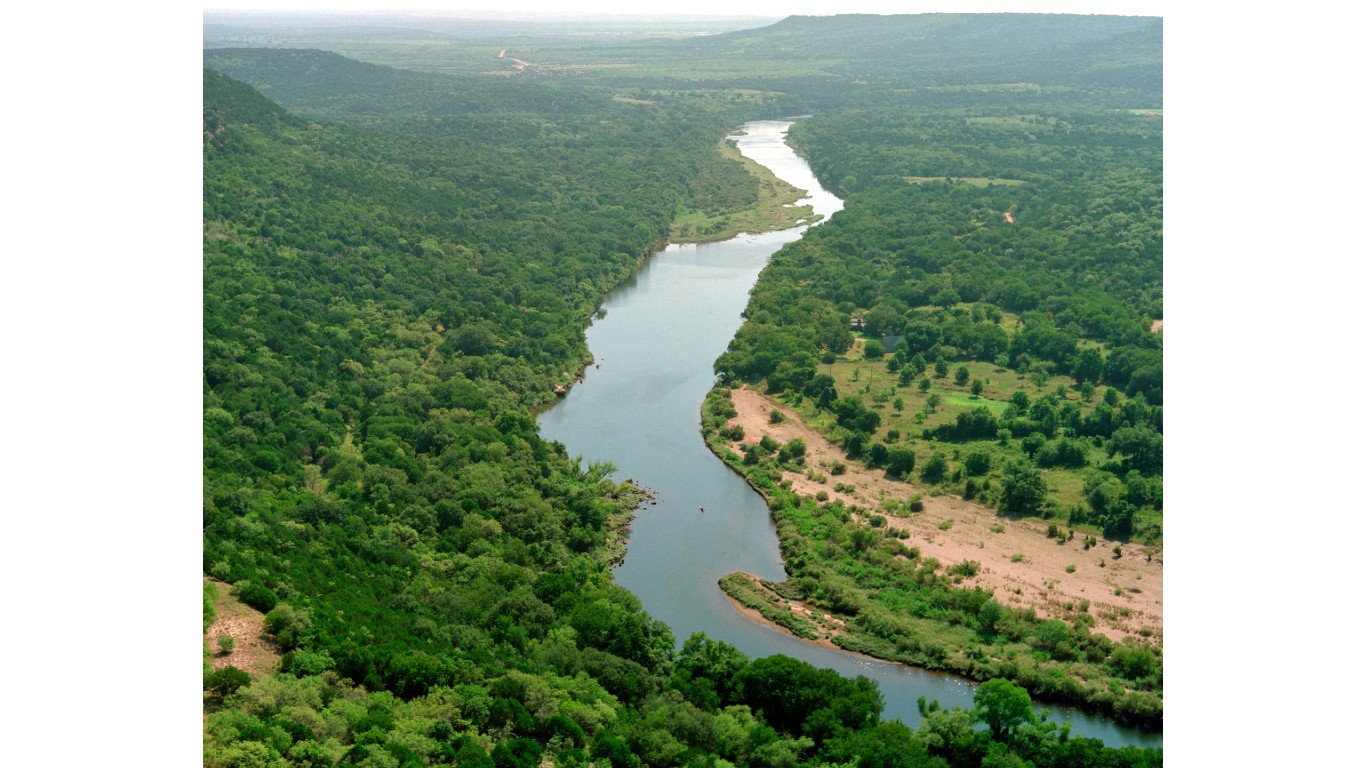


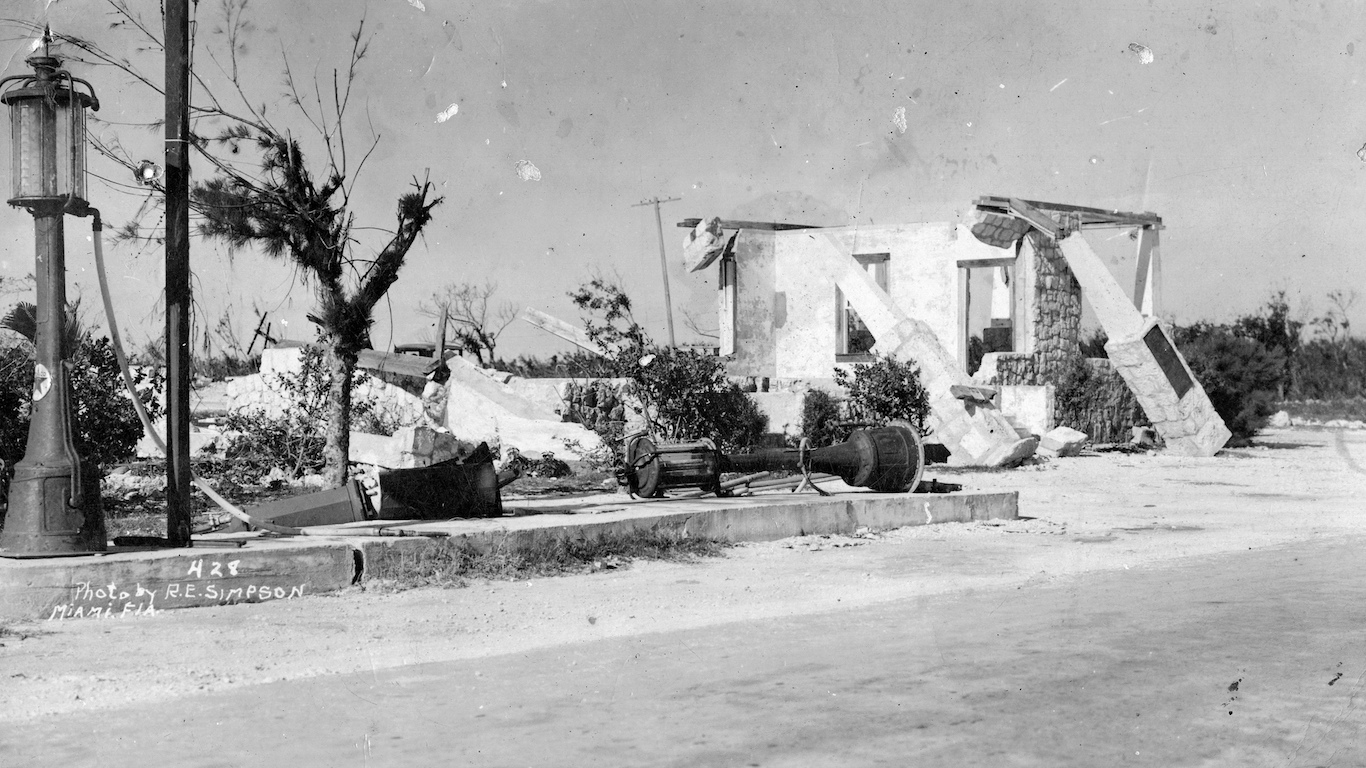
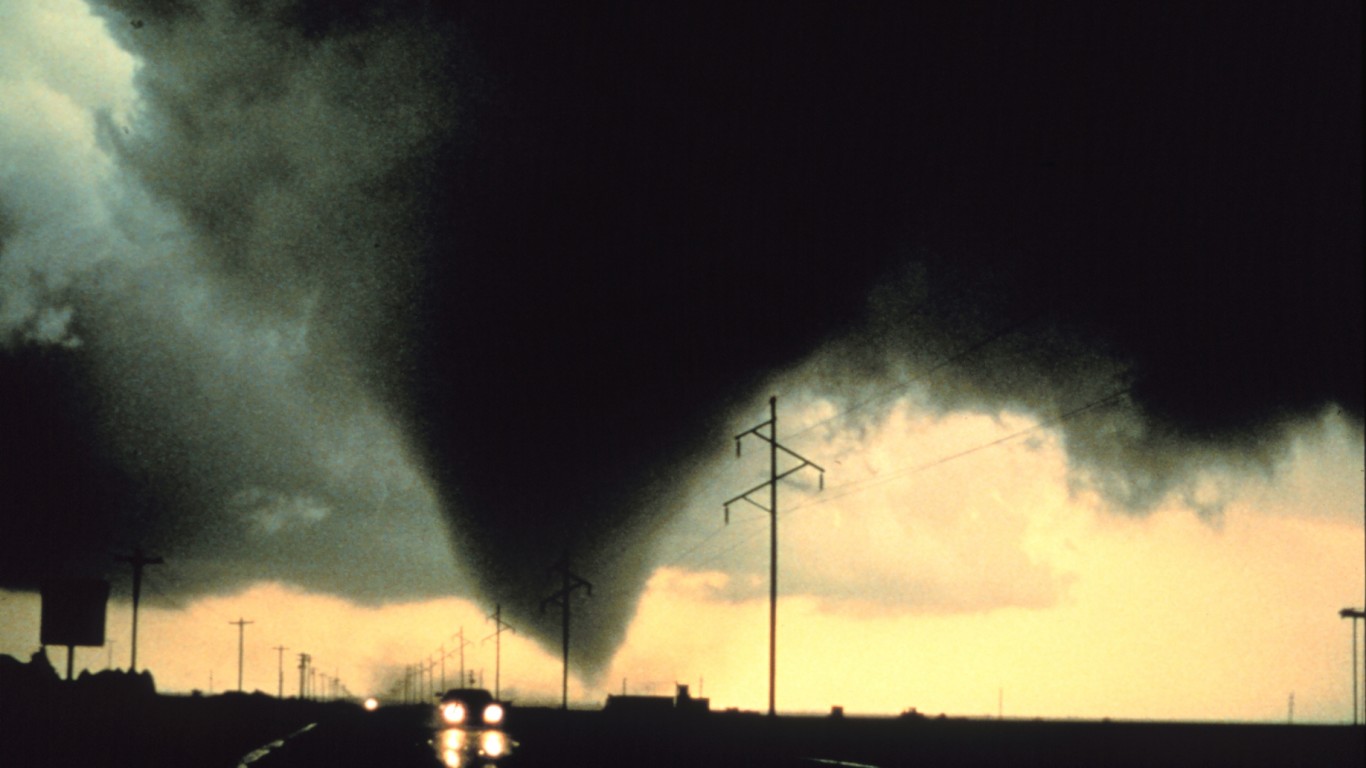 24/7 Wall St.
24/7 Wall St.
